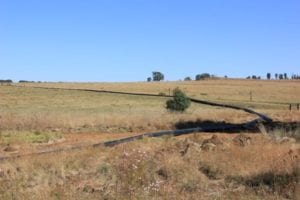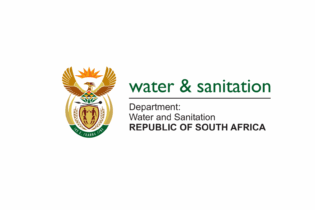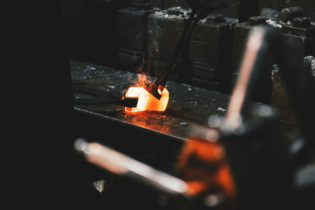Process plants – whether water or wastewater – are reliant on various technologies for successful production. The reality is that these technologies are often forced to work under extremely harsh conditions. Related products such as pipes, pumps and valves must therefore be of uncompromising quality and backed by excellent service.
The scene is set in Ermelo where the demand for water had exceeded supply. Two water treatment works (WTWs) – the South and North – service Msukaligwa Municipality but capacity on the South WTW was not sufficient to meet the increasing demand for water. To counteract the problem, a 14-km, R52 million temporary, emergency bulk raw water pipeline, was supplied. The pipeline was equipped with R12 million worth of high-density polyethylene (HDPE) piping, steel fittings and valves from fluid conveyance and pumping solutions provider Incledon.The pipe was manufactured and supplied in 12 m lengths, with the welding of the pipes handled on-site. The finished HDPE pipeline has a diameter of about 355 mm and can handle pressure ratings of up to 16 bar. “The municipality implemented a water restriction system to control the supply of water but this failed, resulting in an emergency pipeline being identified as a solution,” explains Phillip Bawden, product manager: Incledon. The HDPE pipe was manufactured and supplied based on the company’s Aquaflow brand, and according to SABS 4427 specification. According to Department of Water Affairs (DWA) Minister Edna Molewa,the emergency bulk raw water pipeline will supply surplus raw water to Ermelo and is aimed at tackling the water shortages in the Douglas and Willem Brummer dams. In addition to the emergency pipeline, the DWA provided Msukaligwa Municipality with two water storage tanks, worth R320 000 and R500 000 respectively. Although the issue of immediate water supply was resolved, Molewa said that a long-term measure was still under consideration to solve the water shortage problem in Ermelo. Part of the long-term solution is a parallel process for the provision of a permanent technical solution to provide water for the Ermelo/Wesselton service area through the Regional Bulk Infrastructure Grant. With a project value of approximately R32 million, it should be completed later this year. Under control Unlike Ermelo that experienced a need for increased capacity, there are many WTWs that are able to meet demand but unknowingly experience great water losses. Demand and pressure management – a technique used for minimising water losses in municipal reticulation networks by regulating pressure – is a growing trend in South Africa. This technique is vital, particularly so in water shortage areas. According to Charl Myburgh of DFC Water, the potential savings of a demand management system are enormous.“We recently carried out installation trials on our pressure reducing valves,” he says. “This yielded water savings averaging 20 000 kℓ per valve per month, translating into a monthly monetary saving of R80 000 per valve.” This saving was recorded on a single average-sized installation, covering the entire reticulation network. The first step in demand management is an analysis of network data. This delivers demand profiles, which will indicate when pressure in the system should be lowered to minimise leakage (usually during the night when demand for water is low), and when it should be increased to meet demand (usually during the day when demand for water is high). As Myburgh explains, a system under unnecessary high pressure will suffer seepage. There will also be rapid leakage through cracks or burst pipes, most of which will not reveal itself above ground. However, an effective pressure management system will increase or decrease the pipe pressure according to demand, thereby minimising water losses. At the heart of demand management is the Cla-Val pressure reducing valve (PRV). Installed at strategic points throughout the network, the Cla-Val PRV controls water pressure, each one being linked to an electronic controller pre-programmed with the correct profile for the zone under control.DFC Water recently announced three new Cla-ValPRVs for municipal demand management applications. The valves, imported and assembled locally, conserve water by reducing leakage and improving the efficiency of water reticulation systems. They also save energy and help prevent pipe breaks. “By modulating flows in the various parts of the system, increasing the pressures to supply water to those sections needing it, and decreasing pressures and flows elsewhere to reduce leakage, large volumes of water could be saved from wastage,” he continues. Pump precision As important as it is to select the right valves, it is equally necessary to choose the proper pump for the job. But this does not have to be limited to pumps for use in water applications. Last year, Germiston-based Ecochem Pumps was appointed exclusive distributor of the Soméflu range of chemical transfer pumps throughout South Africa and neighbouring countries. For many years, the company supplied the African market with Milton Roy’s range of chemical dosing pumps. According to Adrien Hourlier, international sales manager for Soméflu, the market for chemical transfer pumps is shrinking in terms of small orders, but growing for larger orders. This is because of the trend towards the closure of smaller plants in many industries and their replacement by larger plants with a greater throughput, which can then take advantage of economies of scale to deliver a lower cost of production per unit. Soméflu centrifugal pumps are designed for transferring corrosive, abrasive and hazardous fluids in mining, chemical, petrochemical, water treatment and other applications, managing the bulk transfer of chemicals from one point to another. The pumps, machined from a block of raw material, can handle a flow rate up to 1 500 m3/h and a 100 m head pressure. Internationally, the company’s main business is within chemical and fertiliser manufacture, petrochemicals and mines, but its technology is also applied to water treatment, which Hourlier sees as an important growth path for the company in Africa. The company recently received a large order for pumps from a platinum mine in the North West and, apart from mining, it is making a concerted effort to target new petrochemical and chemical manufacturing plants in South Africa.Design complexities
In keeping with precision pump design, the new Etanorm type series from KSB Pumps undergoes numerous calculations, simulations and experiments before it is manufactured into a product that meets customer expectations. The series dates back to 1936 and 1.5 million units have been sold to date, making it the most successful standardised water pump in the world. The pump’s success is largely based on the wide variety of design variants and the broad range of applications as a result thereof. The product range comprises conventionally sealed water pumps in a wide variety of designs ranging from variable speed models to the zero-leakage Etaseco. But even good products present their fair share of challenges and, in the case of this series, the challenges lie in innovation. For Dr Norbert Kastrup and his team of development engineers at KSB, the question was: “How do we inject a pump that has already been renowned for its low energy consumption, reliability and durability with fresh momentum?” After much debate, there were two things that provided the impetus for a renewed technical overhaul and optimisation: the first impetus was the result of the demands made by the international market while the second was given by the so-called ErP Directive (European Union Regulation 547/2012), also known as ecodesign directive. Many of the company’s product users are global players who form part of an international network. They tend to favour standardised products, in particular where the stocking of spare parts is concerned. This was exactly the point that had posed a real challenge thus far. Irrespective of its design or features, the Etanorm has very successfully made a name for itself in almost every country in the world. However, over the years, KSB has had to come up with numerous design variations to meet the needs of particular countries, so that although the pumps were still similar at heart, the number of design differences had gradually increased. Not only did this mean that the company had to cope with an enormous complexity of having to produce spare parts and accessories for every single pump series, but the users themselves were also faced with having to stock multiple sets of spare parts, for example, if they ordered pumps both in Europe and in Asia. To eliminate this problem, the company decided to standardise the Etanorm and to set the same quality standards at all production facilities in the world. On the issue of complying with regulation, although many pumps today already meet requirements that will not take effect until 2015, it was still the company’s goal to improve regardless. Its ‘FluidFuture’ campaign is the logical further development of this approach. ‘FluidFuture’ is the name of a concept consisting of all products and services that together make for an energy-efficient way to run a system. The concept is holistic i.e. besides the pump itself, it also looks at the system as a whole through the eyes of a pump expert. Plant operators are also interested in the reliability of their systems. For this reason, the company has added several pump sizes to the selection chart of the type series. And by increasing the rigidity, the pump casings can now absorb higher forces and moments imparted by the pipelines; this makes for a further increase in reliability. The bearing bracket has also been further reinforced to minimise the vibrations generated by the running pump. Moreover, the pump boasts improved suction performance and virtually cavitation-free operation across a wider operating range. Well-oiled machine Regardless of the make or type of pipe, pump and valve, the general consensus is quality, appropriate selection for the specified application, and longevity. General valves and fittings should be carefully located and designed to facilitate the operation of the system. For example, careful routing of the pipeline will minimise the number of costly fittings required while pressure-relief valves should be installed on pumping mains to avoid damage caused by pumping against closed valves. Ultimately, these systems need to work in sync to ensure that you, me and areas such as Ermelo are never faced with water and wastewater-related issues.







